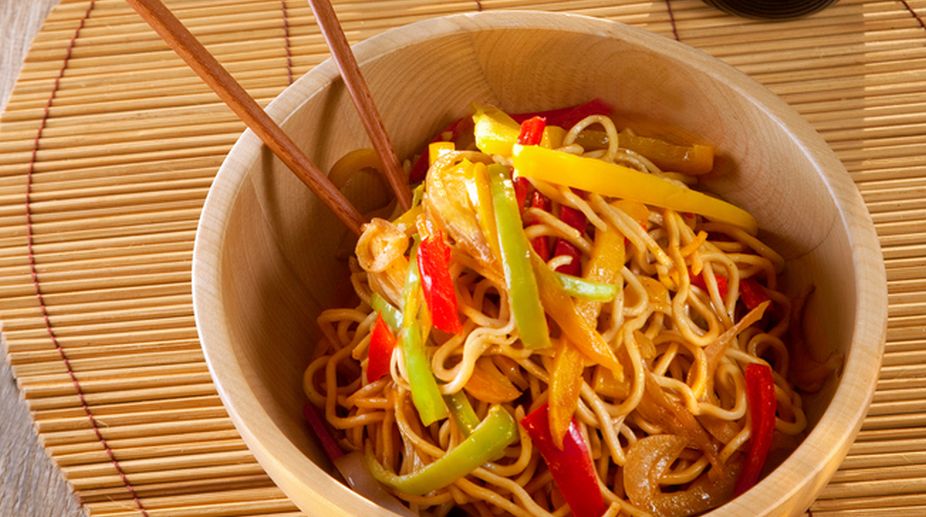Chinese cuisine, cooked by experienced chefs, offers a consistent quality in each of the scores of eateries dotted all across the world. The names of individual restaurants appear to add a special meaning to every dish, where quality remains supreme. William Shakespeare’s words reflect these thoughts, “What’s in a name? That which we call a rose; by any other name would smell as sweet…”
True Chinese food is manifest with brightness and an exotic appearance. For many people must-order dishes rang from sweet and sour shrimps to chilli chicken but the food has a tremendous variety of flavours and styles. “Whatever my mood is, there’s always something that satisfies me from the wonders of a particular Chinese dish,” says Grace Young, author of Stir Frying to the Sky’s Edge. Young asserts that Chinese food is based on colour, taste and aroma.
From hot and spicy tangs and lightly seasoned dishes to being friendly to the most delicate taste buds, Chinese cuisine has something for everyone. Garlic, chili and ginger are often referred to as the holy trinity of Chinese cooking, since these ingredients form a common foundation.
No Chinese chef would be without soy sauce, which provides most of the salty tinge to the cuisine, simultaneously adding to the flavour. Meat is used essentially as a flavouring agent and one must not forget that Chinese food is as much about vegetables, noodles and rice.
Many Chinese restaurant names with words such as, golden, fortune, dragon, garden, or Shangri-la, are selected by owners, because even to articulate these words is considered propitious.
Restaurants catering to this type of food are ubiquitous across most cities and their menus from soups to the main course specialise in preparation of vegetables, chicken, fish and the unforgettable prawns. The US, for example, has an incredible 50,000 Chinese restaurants across small towns, villages and big cities.
Interestingly, Alicia Ault from the US writes that these restaurants are not large chain franchises; on the contrary, they are family owned shops.
The famous film, Chinatown, which was nominated for 11 Oscars, at the 47th Academy Awards, was recorded as being “culturally, historically and aesthetically significant”. It was also significant for its title that sounded dramatic with much suspense, because it was an address in the climactic scenes of the film, with Chinese restaurants dotting the location. People, with features from the Orient peered out of some Chinese restaurants and evoked an aura of intrigue.
Coming back to India and Kolkata, the Chinese restaurant, Waldorf, established in 1954, was a prominent landmark of Park Street. It was owned by the Wong family and in recent times, after the family moved to the US, the ownership changed hands and its present custodian is Charles Mantos. However, the staff confirms that the same Chinese cuisine, of the past, is integral to the tradition of this restaurant even now. Kolkata’s Tangra has always been known for its tanneries, but is also popular for its myriad number of Chinese eateries, that offer both take-away food and seating facilities for diners. The tradition is similar to those the world over, with these restaurants being family run businesses.
The famous location of Hollywood in Los Angeles has its own array of Chinese restaurants, beginning with Yang Chow, and others, with names having words like, wok, garden, house and kitchen. With the colour golden popular in most locales and panda and dragon as animal names, Chinese eateries often have those words in their names.
Andrew Coe, author of Chop Suey: A Cultural List of Chinese Food in the US, writes, “It is an established tradition that names of restaurants, menus and décor rarely change because consistency is intrinsic to the industry.” Coe affirms that changing a Chinese restaurant’s name could “scare” customers away. But the fact remains that Chinese restaurants did not really proliferate until the late 19th century. The Washington Post’s survey, conducted in 2016, encompassed some 40,000 Chinese restaurants in the US, and one third of the restaurants were named using words such as, China and Chinese, with words like, express and panda following. The word, imperial, used in many names, is also significant and reflects China’s past.
Eating this food with chopsticks is integral to the cuisine’s fascinating saga. When President Nixon was invited to China, in 1972, ending many years of hostility between the two countries, the Chinese Premier Zhou Enlai hosted a banquet for Nixon. The leaders, including Mao Zedong, replete with warm smiles, served each other the delicacies of Chinese food and Nixon’s use of chopsticks was as skillful as his Chinese hosts’.
That famous banquet set the stage for negotiating the historic Shanghai Communique, fostering improved relations between the two countries.











